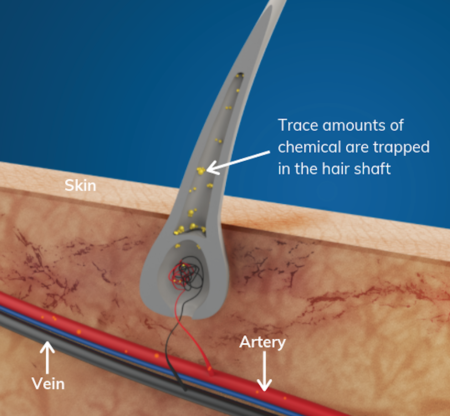The Science Behind Hair Drug Testing Analysis
Psychemedics invented the science that reinvented the drug testing industry.
1979: Our Researchers Changed Drug Testing Forever.
Superior Science. Superior Results. Unrivaled Detection. Unmatched Deterrence.
Although Psychemedics pioneered the commercial use of hair testing for abuse drugs in 1986, our scientists actually have forty years of practical knowledge, publishing groundbreaking research that hair follicles provided a means to detect drug use in 1979. For a drug test using hair analysis, a sample of a person’s hair is sent to a laboratory to detect illicit drug use using various scientifically-validated testing methods. The two tests used by Psychemedics to analyze hair samples for the presence of drugs of abuse are an FDA-cleared immunoassay test followed by confirmation by mass spectrometry (LC/MS/MS or GC/MS/MS in most instances).
The Psychemedics hair drug testing analysis has been choosing the most recognized brands in the Fortune 500, a wide variety and cross-section of national and international businesses, some of the largest and most respected law enforcement agencies, and schools across the nation.
Why?
- Unwavering confidence in your policy decisions. All our drug screens are FDA-cleared.
- Cheating is virtually impossible. A fully observed collection ensures that.
- Wide window of detection. A 90-day record of drug use identifies chronic users.
How The Science of Hair Drug Testing Analysis
Works.
Groundbreaking research by our scientists in the 1970’s found that hair could be a reliable and highly stable medium to detect drug usage.
- Drugs are metabolized by our organs and enter the bloodstream.
- Both the parent drug and its metabolites in the bloodstream are deposited in the growing hair’s follicle.
- As hair grows, these trace amounts of chemicals deposit into the hair strand’s cortex and remain where they are deposited.
- As hair grows beyond the scalp line, the chemicals are collected with a hair sample.
This process forms a historical record of use—like a tape recorder. Each one-half inch of hair holds approximately 30 days of drug usage history. A sample snipped close to the scalp contains a chronological usage record of drug type and quantity. Psychemedics technology extracts that information and equips an organization to identify chronic or habitual drug users. As a note, most often, we test a 1.5-inch sample, giving us a 90-day picture of usage.

170-Year Old Hair Strands Reveal Their Secrets And Tell Their Stories
Not with urine. Not with oral fluids. Only with Psychemedics.
Opium Was This Poet’s Drug Of Choice.
John Keats was a revered Romantic poet who died at age 25 and was long suspected of over-medicating himself with the opium-derived drug laudanum for symptoms of the tuberculosis he suffered. Medically-trained, he was prescribing himself a common painkiller of the era and one that was regularly used by others in the circle of artists with whom he spent his days. The question for historians was whether he came to use opium excessively and whether it may have impacted his works.
In 1985 Werner Baumgartner, the founder of Psychemedics, received a 167-year old sample of the poet’s hair from a rare book collection at the University of Texas. Despite its age, Baumgartner detected increasing usage of the drug before Keats’ death, most likely as a result of the painkillers he was given.
We answered the question about his use of opium.
Whether his work was impacted is a question for the literary scholars.


A Beethoven Myth Debunked.
In 1996, a group of Americans purchased a lock of the composer’s hair with the aim of establishing a center housing Beethoven artifacts. Historians had long theorized that Beethoven relied on morphine to stifle excruciating pain brought on by several ailments during the waning years of his life. One of the investors in the purchase, a physician, wanted a few of the strands tested to determine if the historians’ theories were accurate.
The tests were run by Psychemedics. And the results conclusively proved that in spite of the severe pain he suffered in his final year, no drugs were detected in the final 3-4 months of Beethoven’s life. All because a single lock of hair retained the history of a great composer’s daily rituals of 170 years ago.
A longstanding myth about a revered composer debunked.
Not possible with a urine test. Not possible with oral fluids.
Dispelling Three Hair Testing Myths
(Things that just aren’t true.)
Can you spot three drug users in this crowd?
Psychemedics can.
It is what we do every day.
The Psychemedics Advantage
Your objective is a drug-free workplace or campus.
Your challenge is to Detect and Deter every drug user.
Unrivaled Detection. Unmatched Deterrence.
That is the Psychemedics Advantage.
Drug News You Can Use
Sign up for our quarterly newsletter to stay up-to-date with snapshots of usage statistics, information on the latest trends, and updates on detection science.



